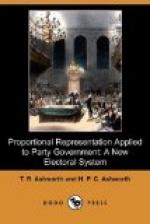We have shown that representation means the organization of public opinion into two definite lines of policy, and that this is the only way to prevent political anarchy. But the proportionalists (as they like to call themselves) say that it means representing men and the opinions they hold in proportion to their numbers. The fundamental error is that they neglect the all-important factor of human nature. They look on public opinion as something having an independent existence apart from the questions about which it is expressed and from the means of expressing it; and they fail to recognize that the character of public opinion depends on the manner in which it is expressed and organized. It is but a natural consequence that they also conceive the number of sections of opinion awaiting representation as pre-existing and independent of the electoral machinery.
In short, they reduce the whole problem to a nice little exercise in mathematics, requiring only for its clear exposition some columns of figures and a few coloured diagrams to represent the different shades of public opinion. No better example of the dangers of a priori speculation could be adduced than this chimerical idea of the proportionalists that public opinion is something to be divided into fractions like a mathematical quantity, unless it be, perhaps, the conclusion that if you gather together delegates representing these fractions you will have an assembly representing the sum total of public opinion.
The issue is quite clear. Are we to have two parties aiming at the control of administration and appealing to all sections for support, or the separate delegation of a number of sections? In the one case we will have parties based on national policies, and in the other case we will have a number of factions, each wanting something different and determined to block progress till it gets it. Remember that it is a mere matter of electoral machinery which will determine the choice. It is true that at present we do not have two very coherent parties, but that is the fault of the present electoral system.
It would seem that there can be but one answer to this question, and yet the “representative principle” shows such wonderful vitality that it is worth while considering the arguments on which it is based, and the various stages through which the idea has passed.




